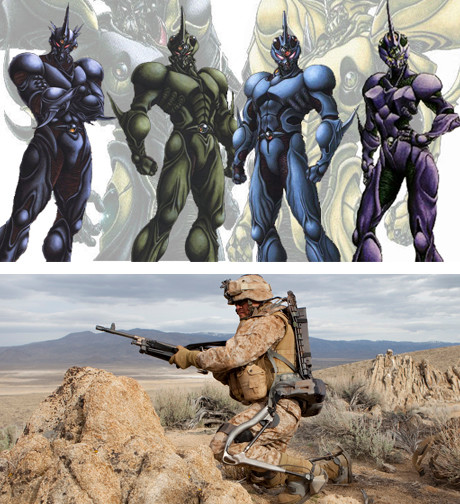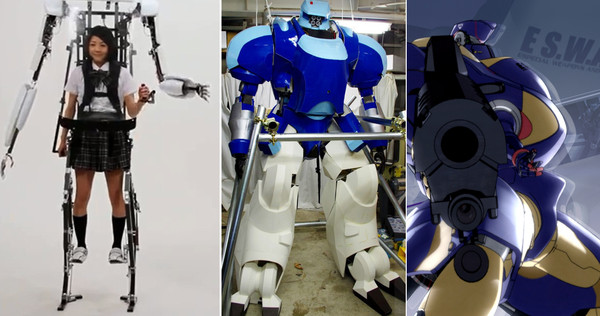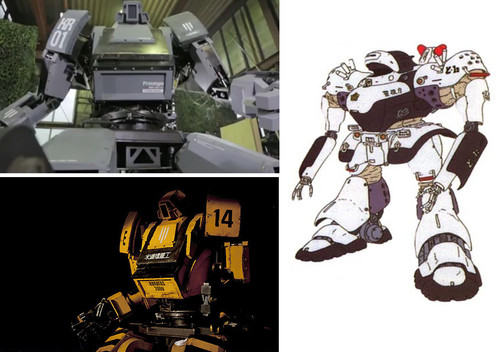Interest
Anime Robots That Made the Jump From Sci-Fi to Reality
posted on by Bamboo Dong
Robots have been a staple of science-fiction for decades, filling our imaginations with androids, cyborgs, giant pilotable machines, and more. With the way technology is now, it's not just a dream anymore. Here's some of the latest robots that have made the leap from fiction to reality.
Power Armor

Some may argue that giant mechs are more useful in a wartime (or alien-combatting) scenario, but for everyday military or law enforcement needs, a power suit is where it's at.
While we're not quite at the point where our criminals are apprehended by Knight Sabers (or Iron Man), there has been an incredible amount of work and progress in the field of powered exoskeleton research.
Raytheon's XOS Exoskeleton doesn't have any built in weaponry, but it lets the wearer lift up to two hundred pounds, and is one of the few full-body power suits being developed... that we know about, of course. Originally created by Sarcos, it was envisioned for usage in military applications, letting soldiers carry heavy loads over long distances, or rescue their comrades.




|
Androids and exoskeletons may be popping up in reality, but robots in anime are starting to get a more realistic treatment, too. In the near-future series Robotics;Notes, a school club tries to build a mecha inspired by their favorite anime (it's a little bit meta) using scrap parts. It turns out that being a high schooler with little-to-no engineering knowledge makes building a giant robot just as hard as you might imagine. That's just the tip of the iceberg, though. You can pick up Robotics;Notes on Blu-ray & DVD from FUNimation and find out more for yourself. |
Ad by FUNimation | |
Check out this video Raytheon made to show off their latest model to actor Clark Gregg, whom many movie fans might recognize as Agent Phil Coulson from Marvel's current Avengers film and TV universe.
Lockheed Martin's HULC (Human Universal Load Carrier) was likewise designed for military use, allowing wearers to carry heavy loads over complex terrain. Developed by Berkeley Bionics, once strapped on, it redistributes weight through the titanium legs, while still allowing for natural movement.

Here's the suit in action:
Aside from military applications, exoskeletons have also been heavily researched for their ability to aid the disabled, whether it's helping users regain mobility, or aid in rehabilitation efforts.
Startup Ekso Bionics has a wearable bionic suit that has shown success in allowing patients with complete paralysis to stand and walk.
Meanwhile, Japan's Cyberdyne (no, not that Cyberdyne) has been making strides with their HAL (Hybrid Assistive Limb), which claims to be the world's first cyborg-type robot, a "fusion of man, machine, and information." The wearable suit has been tested for its ability to perform heavy lifting and restore walking ability to those with special physical needs.

Of course, if you're less about functionality and more about aesthetics, you can also get your hands on a more anime-inspired invention. Appleseed fans can also get one of their very own Landmates... sort of. Recently, efforts from model and garage kit manufacturer Dai Nioh Giken have made it possible to turn Sagawa Electronics' Powered Jacket MK3 exoskeleton into an Appleseed Landmate, thanks to attachable armor.
It's not cheap, though. At ¥12.5 million ($123,600), it's more affordable than a Kuratas, but probably more than a little out of reach for the average consumer.
Here's a shot of the exoskeleton by itself, alongside the attachable armor that turns it into a Landmate.

And just in case you were wondering how well it runs:
The Powered Jacket MK3 isn't quite as useful as the other exoskeletons, though. For starters, even though it strikes an incredible silhouette, it only lifts a measly 2KG (4.4 lbs).
Interactive Dolls

Chobits isn't the only series to feature interactive humanoid computers, but it has been a fan staple since its release in 2002. Now, over ten years later, we might finally have the technology to play with our own interactive dolls.
Internet personality and Culture Japan director Danny Choo has been working on the Mirai Suenaga Smart Doll, a figure-sized doll that can move and respond to its owner via an Android app. According to the website, the doll's aim is to serve as an "interactive home appliance" that helps users "bid farewell to roneriness."
If you're eager for your own, you won't have to wait long. The doll is due out sometime in 2014.
Of course, the Smart Doll won't be able to do most of the things a fully loaded Persocom can do, but it seems like a good start.
Of course, if you don't need your robot companions being beautiful girls, you can also try and get your hands on a Kibo, who managed to be the very first robot to hold a conversation in space with a JAXA astronaut.
The robot's goal? To "help solve the problems brought about by a society that has become more individualized and less communicative."
Kibo was created by robotics expert and university professor Tomotaka Takahashi, who has invented dozens of other robots, some of which are consumer friendly to the tune of around $100. Amongst them is Robi, an adorable little interactive robot that can understand and converse in 200 languages. Check out the Robo Garage official website.

Android Helpers

If everyone had their own android helper, life would be so much easier. Naturally, they'd be gobbled up by law enforcement agencies and the military, but even just for household use, they'd be a real help. Imagine never having to take out the trash ever again, or cleaning up after a party.
Maybe androids the style of Ghost in the Shell aren't quite a reality yet, but there are plenty of helpful robo helpers who can do our dirty work for us.
Take NASA's Valkyrie robot, which is destined for Mars. It can drive utility vehicles, navigate complex terrain, remove debris, open doors, climb ladders, and all sorts of useful tasks.
And of course, everyone knows about Asimo, Honda's advanced robot that can climb stairs, play host, do heavy lifting, and respond to gestures and facial expressions. Those eager to see Asimo up close can now visit the little guy at his current home inside Disneyland's Tomorrowland.
Boston Dynamics has been making big strides, too, with their android PETMAN, designed to test chemical protection clothing. Its main job? To move as freely as possible, to ensure that protective clothing holds up under the same rigorous movements that might be used by soldiers. Here's PETMAN putting a suit through its paces:
Mechs You Can Ride In

Sure, AI friends and robot servants all seem like cool toys to have, but who wouldn't want to ride to work in an actual, pilotable mech? Well, if you ever find yourself with a spare $1.35 million, that dream can become a reality.
Suidobashi Heavy Industry's Kuratas, a hydraulic 4-meter, 4-ton rideable robot designed by Kōgorō Kurata, is highly customizable, and allows buyers to add-on a variety of accessories, like gatling guns and a pilebunker.
Aside from just being a rich person's plaything, the Kuratas will also have a role in the upcoming live-action Patlabor film, where they will play the part of construction Labors. Of course, they're a little less flashy than the life-size Ingram robots being used in the film, but they're a lot more functional.
Here's a picture of an unmodified Kuratas, with a screenshot from the Patlabor movie, alongside a law enforcement AUKA-MPL-96 Labor.

And just in case you needed a primer on how to drive one of these things:
[images from Patlabor Wiki, Fembot Wiki, Otaku Ninja Academy, Nipponista, Simomu]
this article has been modified since it was originally posted; see change history